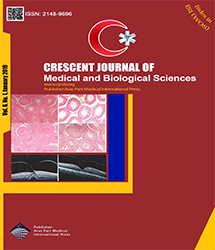
| Original Article | |
| Investigating the Exposition Rate of Regulatory Genes of Cell Cycle Phase G2/M in Patients With Stomach Adenocarcinoma by the Meal Prescription of Polyunsaturated Fatty Acids Before and After Chemotherapy | |
| Ali Rezazadeh1, Homayun Dolatkhah1, Ahad Mokhtarzadeh2, Saeedeh Hozhabr1 | |
| 1Department of Biochemistry, Faculty of Higher Education Institute of Rab-Rashid, East-Azerbaijan, Tabriz, Iran 2Department of Immunology Research Center, Faculty of Medicine, Tabriz University of Medical Sciences, East Azerbaijan Tabriz, Iran. |
|
|
CJMB 2019; 6: 037-045 Viewed : 5110 times Downloaded : 5153 times. Keywords : Stomach adenocarcinoma, PUFAs, G2/M phase of the cellular cycle, Cyclin, cyclin B1, CDK1 |
|
| Full Text(PDF) | Related Articles | |
| Abstract | |
Objectives: Cancer is a hyperactive disorder which can cause uncontrolled propagation of the cells. Several reports indicated that omega polyunsaturated fatty acids can prove their own antitumor effects on different cancerous cells by stopping the operation of the cellular cycle. Therefore, this study mainly aimed to investigate the impact of omega polyunsaturated fatty acids (PUFAs) on the exposition rate of genes CDK1, CyclinB1, and the cellular cycle of the stomach cancerous tissue in under-chemotherapy patients with stomach adenocarcinoma. Materials and Methods: The present study was a double-blind clinical trial in which neither the oncologist nor the patients were aware of the treatment before and after the intervention. The patients with stomach adenocarcinoma were first recognized and subjected to chemotherapy. A total of 24 patients were randomly selected and included in the case and control groups. The patients in the control group were treated with cisplatin and placebo while those of the case group first received cisplatin with the complementary capsule of fatty acids, namely, Natural Factors Ultimate Omega Factors with a dose of 1200 mg and 3600 mg daily, encompassing three 1200 mg medicines each course for 3 weeks. Three samples of the stomach biopsy were taken from all patients before and after the chemotherapy. All mRNA tissues were extracted out of the biopsy samples. Then, DNA was synthesized based on these samples and the exposition rate of the desired genes was measured using the real-time polymerase chain reaction (PCR) method. Results: There was a significant decrease in the mean of exposition of the genes in the case group (P = 0.021) compared to the control group (P = 0.001). Conclusions: Generally, the results revealed that using omega fatty acids 3, 6, and 9 along with cisplatin medicine can be effective in stopping the cell cycle phase G2 in cancerous cells of the stomach tissue. |
Cite By, Google Scholar
Google Scholar
PubMed
Online Submission System
 CJMB ENDNOTE ® Style
CJMB ENDNOTE ® Style
 Tutorials
Tutorials
 Publication Charge
Medical and Biological Research Center
About Journal
Publication Charge
Medical and Biological Research Center
About Journal
Aras Part Medical International Press Editor-in-Chief
Arash Khaki
Deputy Editor
Zafer Akan


















